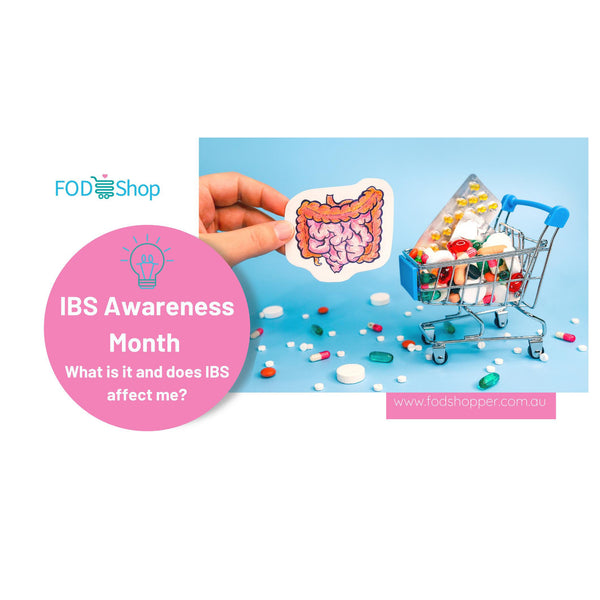- Ph: +61 435 003 412
- operations@fodshopper.com.au
"Organic Orange" has been added to your cart. View cart
"Organic Orange" has been added to your cart. View cart

IBS is a common condition characterised by chronic symptoms of bloating, constipation & diarrhoea (or a combination of both), excessive flatulence, bloating & distension, and abdominal pain. (1)
IBS is classified as a 'Functional Gastrointestinal Disorder' (FGID), involving the gut-brain connection. The nerves in the gut are stimulated directly by the brain's stress response, leading to gastrointestinal symptoms. (4)
While there is no actual damage caused to the gut, the symptoms of IBS can be embarrassing to talk about and the psychological impact of them on daily activities including work, school, socialising, and leisure can be very debilitating for sufferers.
It is estimated 1 in 5 Australians experience IBS-type symptoms, with estimated of 15-25% of the Australian population affected.
Two in 3 of those with IBS are women, and the disorder affects individuals of all ages, from children to the elderly.
It is estimated that the worldwide prevalence of IBS is 8-16%, equating to more than 1 billion individuals suffering the daily burden of this chronic gastrointestinal disorder.
Research is still developing into the cause of IBS, as this is still a research question that is poorly understood. (1)
While post-traumatic stress, psychological abuse, anxiety, famine, and previous generational war exposure are common in many IBS patients, the true cause of the condition remains unknown.
IBS is diagnosed according to the Rome IV Criteria which recommend that, in order to make a diagnosis of IBS, the following must occur:
"Recurrent abdominal pain on average at least 1 day/week in the last 3 months, associated with two or more of the following criteria:
Make sure to discuss any symptoms with your doctor. (5)
The typical symptoms of IBS may occur when foods high in Fermentable Oligosaccharides, Disaccharides, Monosaccharides and Polyols (FODMAPs) are consumed.
When FODMAPs are consumed, they attract water in the small intestine, causing diarrhoea, abdominal pain & cramping. When FODMAPs reach the large intestine, the resident gut bacteria quickly ferment the FODMAPs, causing gas, flatulence and painful bloating. (2)
Many dietary IBS symptom management strategies have been postulated & attempted in recent decades, however the low FODMAP diet has shown the strongest evidence of efficacy, with 68-76% of patients experiencing symptom improvement within 3-4 weeks of commencing the diet. (3)
A thorough exploration of the role of the low FODMAP diet in IBS symptom management will be made in next week's blog - 'The Role of the Low FODMAP Diet in IBS Symptom Management'
The best plan of action is to make contact with an Accredited Practising Dietitian (Australia) or Registered Dietitian (NZ, Canada & USA), as such practitioners are experts in the implementation of the FODMAP diet. Many are also Monash University Low FODMAP Diet trained.
It is highly recommended that you do not attempt the low FODMAP diet alone, as the chances of successful implementation are lower.
If you are recommended to commence a low FODMAP diet, you will follow a 3 step process designed to alleviate your symptoms and allow for reintroduction of triggering foods.
Here the goal is to alleviate your symptoms by swapping high FODMAP foods like onion, garlic, legumes, wheat and cow's milk for low FODMAP alternatives such as potatoes, kiwi fruit, lactose-free milk and eggs.
More information on low and high FODMAP foods can be found here. (6)
Looking for a low FODMAP recipe to get you started? Click HERE.
Whilst following the low FODMAP diet, dietary challenges are used in order to determine tolerance to high FODMAP foods. This will determine individual FODMAP tolerance thresholds. (6)
Some tips when following this phase include:
It is important that the reintroduction phase occurs after 6-8 weeks and the elimination phase is not continuously carried out. (8) Continuing this first phase of the diet for any longer can negatively impact the gut microbiome, and/or cause disordered eating and nutrient deficiencies. (8)
In order to achieve symptom relief, well-tolerated foods are reintroduced, whilst poorly tolerated ones are limited. For the long term, the idea is to prevent diet restriction as much as possible, whilst managing symptoms. (6)
A non-invasive therapy designed to mend the connection between the gut and the brain with the help of a qualified therapist.
Try Nerva HERE, a digital hypnotherapy app designed to unlock the power of the mind and manage IBS symptoms from the comfort of your own home.
Furthermore, yoga and light exercise may increase an anti-inflammatory response in the immune system and decrease constipation. Learn more on the 'Can Exercise Help your IBS Symptoms' Blog.
Finally, medications/alternative medicine such as antipsychotics, tricyclic antidepressants, atypical and natural medicines may help. Ensure a visit to your doctor to discuss what is best for you.
Mintec Peppermint IBS Relief capsules containing medicinal grade peppermint oil (a natural antispasmodic), can alleviate IBS symptoms.
Keen to learn more? Check out the Stress and IBS Managing the Symptom Cycle Blog.
1. Barrett JS. How to institute the low-FODMAP diet: How to institute the low-FODMAP diet. J Gastroenterol Hepatol [Internet]. 2017 [cited 2022 Mar 17];32 Suppl 1:8–10. Available from: https://pubmed.ncbi.nlm.nih.gov/28244669/
2. About FODMAPs and IBS | Monash FODMAP - Monash Fodmap [Internet]. Monashfodmap.com. [cited 2022 Mar 17]. Available from: https://www.monashfodmap.com/about-fodmap-and-ibs/
3. Tuck C, Barrett J. Re-challenging FODMAPs: the low FODMAP diet phase two: Re-challenging FODMAPs. J Gastroenterol Hepatol [Internet]. 2017 [cited 2022 Mar 17];32 Suppl 1:11–5. Available from: https://pubmed.ncbi.nlm.nih.gov/28244664/
4. Rome IV Criteria - Rome Foundation [Internet]. Rome Foundation. 2022 [cited 17 March 2022]. Available from: https://theromefoundation.org/rome-iv/rome-iv-criteria/
5. IBS vs IBD [Internet]. Crohn’s & Colitis Foundation. [cited 2022 Mar 17]. Available from: https://www.crohnscolitisfoundation.org/what-is-ibd/ibs-vs-ibd
6. Treating ibs with a 3-step fodmap Diet [Internet]. Monashfodmap.com. [cited 2022 Mar 17]. Available from: https://www.monashfodmap.com/documents/5/3-step_FODMAP_Diet.pdf
7. Varney J. Practical tips for FODMAP reintroduction [Internet]. Monashfodmap.com. Monash Fodmap; 2020 [cited 2022 Mar 17]. Available from: https://www.monashfodmap.com/blog/practical-tips-fodmap-reintroduction/
8. Hill P, Muir JG, Gibson PR. Controversies and recent developments of the low-FODMAP diet. Gastroenterol Hepatol (N Y) [Internet]. 2017 [cited 2022 Mar 17];13(1):36–45. Available from: https://www.ncbi.nlm.nih.gov/labs/pmc/articles/PMC5390324/

Leave a reply